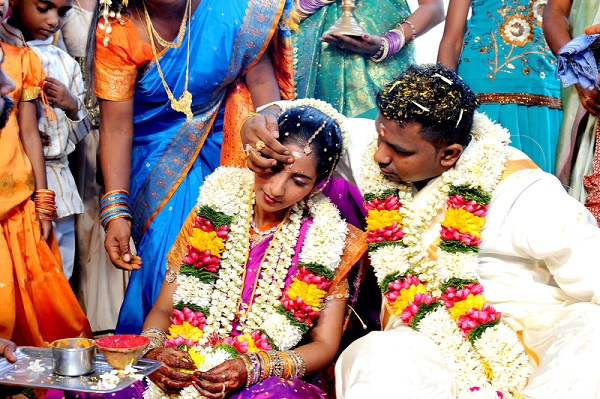

Society is run by rules and regulations. In the same way, they have few regulations for marriage which it binds individuals to marry or not. While choosing a mate people to have to follow certain suitability rules because it is considered that marriage controls and regulates sexual behaviour. The person might be prohibited from acquiring the mate based on these regulations to prevent inbreeding disadvantages (physical defects, abnormalities may develop in close relatives), and social role conflicts and it can be advantageous for a social alliance between different clans or families if marriage within the family is prohibited.

South Asian Wedding
The proscriptive rule is a marriage regulation followed by a major proportion of society, which tells whom a person should not marry. It follows a universal norm which restricts marriage and sexual relations between close blood relatives like brother-sister, mother-son, father-daughter, first cousins who are children of parent’s sibling up to fifth generation. Ancient Greek and Hawaiian Royal families are exceptions to this as they believed royalty could not be passed down to any other royal member.
The prescriptive rule is a marriage regulation which directs an individual whom he can/should marry. The prescribed norms include the rule of endogamy and exogamy to which a person has to adhere while selecting a mate.
Endogamy means marriage within a social group in order to preserve the purity of the group. It is the marriage with members of the same faith, religion, caste or tribe as seen in Hindu Society.
Exogamy refers to marriage outside the group to which a person is not a member. According to some scholars like Tylor and Audrey Richards, it emerged as an outcome for group survival and maintaining peaceful relations with other groups.
Preferential Rule directs an individual whom he prefers to marry. Cousin marriage, levirate and Sororate are examples of preferential marriage.
Parallel-cousin marriage is when children of siblings of same sex marry like a father’s brother’s daughter as observed in Islamic societies. Cross-cousin marriage is between the children of siblings of opposite sex (brother-sister).
Levirate is a marriage form in which the younger brother marries the deceased elder brother’s wife while sororate is its complementary practice in which a widower marries the sister of his dead wife.
Mate selection is a process of selecting a mate who is the best social match for a person. According to Social exchange theory, it is a process of selecting a mate with desired resources. Complementarity theory states that choosing a mate with complementary characteristics with reference to their own need, while Positive Assortative mating theory states that an individual selects a mate who is similar in values, socioeconomic status and education.
There are certain customs prescribed by different societies to acquire a person as a mate. Some of them are outlined below
Marriage by negotiation − It is a system in which a third party is involved who is a common link and known to both bride and groom’s family. He sends the proposals on behalf of either of the families. Mostly followed in Hindu Society.
Marriage by exchange − This system is followed if there are daughters or sisters for the exchange of the groom. It is followed in Muria Gonds tribe, Bagia of Bustar, etc.
Marriage by service − This system is prevalent among Nagas of North-East India in which if the groom’s family is not able to pay the compensation for the bride, the boy has to provide services in the bride’s family. Marriage takes place only after satisfaction.
Marriage by probation − In this system, the groom has to live at the bride's house on a trial basis with the consent of the family and the girl to get to know each other. If the girl is satisfied, marriage takes place otherwise compensation is paid in cash by the boy. It is prevalent among Kukis of Manipur.
Marriage by capture − It can be physical or ceremonial capture. In the former one, the boy from one village captures and marries a girl from another village as seen in Yahomamo of Venenzuela while in the latter case, boy proposes to a girl by holding her hand or putting vermillion during a community fair or festival as seen in Kharia and Birhor of Bihar.
Marriage by intrusion − In this system, the girl intrudes into the house of the boy and forces him to marry, seen in the case of Ho and Birhar of Bihar and Kamars of Madhya Pradesh.
Marriage by trial − The groom is selected by trial in this system. He has to prove his valour and strength as shown by Lord Ram during Swayamvar of Sita. Such marriages are found in Bhils of Rajasthan.
Marriage by elopement − It is a customary practice of Karbis of Assam where it is difficult for the families to bear the huge wealth of the marriage rituals so marriage is done by elopement.
Conclusion
The society has proposed certain regulations for marriage which divides the kinship into marriage and non-marriageable categories. Prescribed norms imply the strictly followed rules by society while preferential norms imply rules which are preferred but not followed strictly. While selecting a mate, a person follows criteria based on suitability and sorts by the rules.
Q1. What is incest taboo?
Ans. Incest taboo is the cultural prohibition of marriage and sexual relation between the closely related members of a kinship.
Q2. How is bridewealth different from dowry?
Ans. Bridewealth is the compensation paid by groom’s side to bride’s family for the right of her labour and reproductive capabilities while dowry is the amount paid by bride’s family to groom’s family.
Q3. What are types of cross-cousin marriage?
Ans. It is of two type: matrilateral cross-cousin marriage is when a man marries the daughter of his mother’s brother while patrilateral cross-cousin marriage is between man and daughter of his father’s sister.